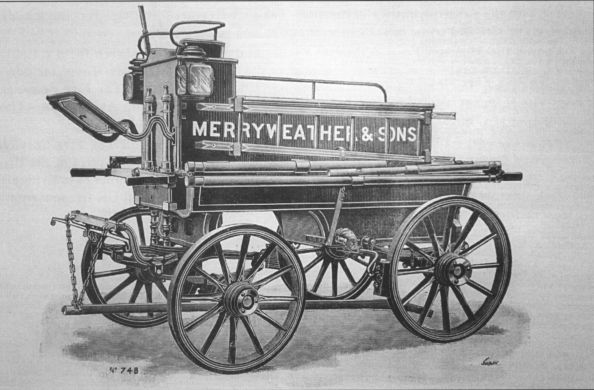|
cylinder, and
multiplying it by by the number of strokes managed by the pumpers, it was
a simple thing to compute the quantity of water that was being discharged
onto the flames.
The hose box, accessed from the hinged top, had a storage area of more
than 20 cubic feet. One of the later refinements to this was a spring
catch that locked automatically when the lid was closed. This held either
eight 40ft lengths of 2½ inch hose or 15 lengths of 1½ inch delivery.
When fully stowed the appliance carried almost 7cwt of hose and equipment
and with a four man crew and coachman the fully laden appliance tipped the
scales at over 1½ tons.
In Massey Shaw's instructive and widely read book Fire Protection,
first published in 1876, he gives a long detailed description of the London
Brigade 6 Inch manual pump. In it he gives much attention to
the workings and construction of the engine. His revised and updated
second edition printed in 1890, fourteen years later, shows no changes at
all to these or alterations to his diagrams. The only improvements noted
appear to be to the pole and sway bars, and method of harnessing the
horses.
By the turn of the century the model had won at least forty first prize
medals. awarded at the numerous exhibitions it attended around the world.
These included gold medals as far afield as Moscow, Paris, Barcelona, and
Melbourne. Nearer home prizes were also gained at Liverpool, 1886;
Cardiff, 1888; and London in 1890, 1891 and 1892.
Demand for the product was good and the engine was still being advertised
and sold well into the early part of the 20th century, a glowing tribute
to the quality of British design and engineering.
'Friends' with an interest in manual fire engines will find a
number of London Brigade engines on display around the country. The
London Science Museum has a fine example in its section devoted to
firefighting. That particular pump was purchased by the Duke of Portland
in 1899 for his Welbeck Estate. Another fine specimen can be found in
Surrey finished in a distinctive blue livery of Wooton House with the date
1883 on its body.
|
